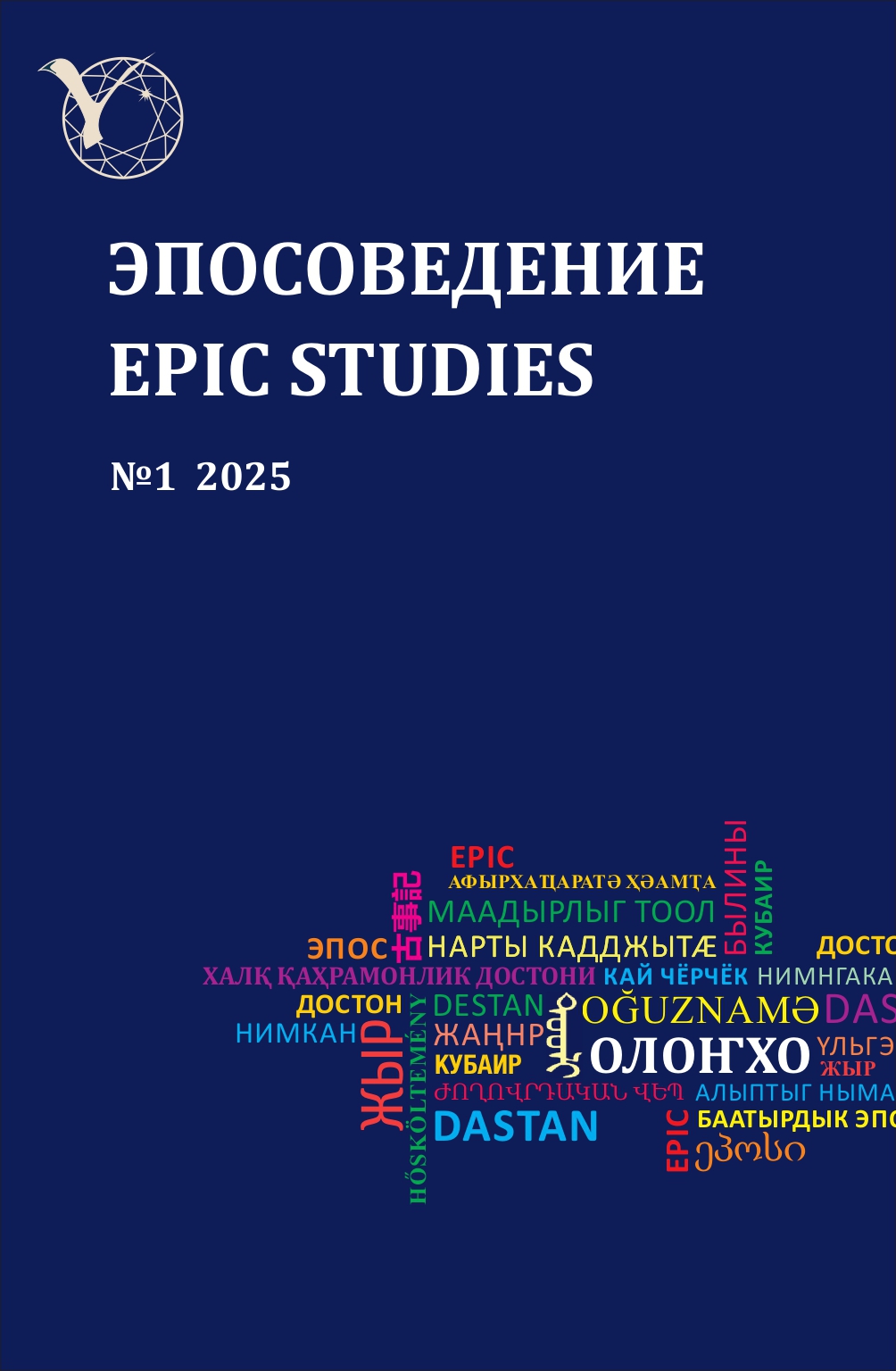Agricultural folklore-linguistic attributes of the Mordovian people: lexeme kshy
DOI:
https://doi.org/10.25587/2782-4861-2025-1-45-58Keywords:
Mordovian language; paroemia; proverb; saying; riddle; gastrononym; oral poetic language; folklore; national picture of the world; mentality; food picture of the worldAbstract
The article is devoted to one of the relevant and promising topics of modern linguistic folklore studies and ethnography – bread, a phenomenon of traditional ethnic culture. Bread is a significant part of the food traditions of the Mordovian people and the most conservative element of material culture. Bread retains its eternal significance in the ritual sphere of the Mordvins, acts as an integral part of the rite and is endowed with sacred meaning. In the traditional food picture of the world of the Mordvins, bread is a spiritual center of power that is present on every family table, ensures the native home existence and it is an expression of ethnic self-awareness. The paper reconstructs the etymological meaning and historical development of the lexeme kshy ‘bread’. The article attempts to show the role and place of bread in traditional prayers, in some family and calendar rites, with bread as an important sacral symbol and one of the most ancient archetypes in Mordovian culture. Based on the semantic analysis of folklore works, ethnographic, archival, field, lexicographic data, the original tradition of bread baking, features and methods of baking ritual bread are revealed, its connection with all stages of the life cycle – from birth to death – is emphasized. Bread is an important attribute in the most important moments of a wedding. The relevance of the study is dictated by the need to establish the functional, value and mythological attributes of bread. The scientific novelty of the work lies in the attempt of a comprehensive study of the cultural phenomenon of kshy ‘bread’ in the Mordovian linguistic picture of the world within the framework of ethnolinguistic and ethnographic approaches. The fragment research of the linguistic picture of the world allows us to study the word not only as a sign of language, but also as a phenomenon of national mentality. The research methodology is based on the linguocultural analysis of folklore works and the interpretation of ethnographic, archival, and field data.
References
1. Balashov VA. (eds.) Mordva: historical and cultural essays. Saransk, Mordva Book Publ. House; 1995:624 (in Russian).
2. Belitser VN. Folk clothing of the Mordovians. Moscow: Nauka Publ.; 1973:215 (in Russian).
3. Heikel AO. Mordvalaisten Pukuja ja Kuoseja: Trachten und Muster der Mordvinen. Helsingfors: Suomalaisen Kirjallisuuden Seuran Kirjapainon Osakeyhtiö; 1899:611 (in German).
4. Rogachev VI. Semantics of signs of arts and crafts. Saransk: MSPI Publ. House; 2005:47 (in Russian).
5. Evseviev ME. Selected works: in 5 vols. Saransk: Mordva Book Publ. House; Vol. 1.; 1961:384; Vol. 2.; 1963:528; Vol. 5.; 1966:552 (in Russian).
6. Zabrovsky AP. Bread as a cultural phenomenon. In: Pavlovskaya AV., Rutsinskaya II. (eds.) Food and Culture: Materials of the 1st International Scientific and Practical Symposium “Traditional Culture in the Modern World. History of Food and Nutritional Traditions of the Peoples of the World”. Moscow: Center for the Study of Interaction of Cultures; 2015:149‒162 (in Russian).
7. Egorova OA. Gastronomic traditions in Russian folk tales: from the past to the present. Scientific notes of the National Society of Applied Linguistics. 2021;1(33):43‒52 (in Russian).
8. Ustinova NA. Food code as food tradition symbolizing. Tomsk State University Journal. 2010;(333):28‒31 (in Russian).
9. Tsygankin DV., Mosin MV. Etymological dictionary. Saransk: Mordva University Publ. House; 2015:228. (in Moksha, Erzya and Russian).
10. Dal V. The explanatory Dictionary of the living Great Russian Language. Vol. 4. Moscow: State Publ. House of Foreign and National Dictionaries; 1956:683. (in Russian).
11. Aasmyae N. Let’s speak Erzya. Tartu: Tartu Ülikooli; 2015:136 (in Russian).
12. Stepanov YuS. Constants: Dictionary of Russian Culture. Research Experience. Moscow: School “Languages of Russian Culture”; 1997:824 (in Russian).
13. Volgapova AN., Kulakova NA., Rogozhina VF. Cultural values in the proverbs, sayings and phraseological units of moksha people. Ogarev-Online. 2014;15(29):1‒5 (in Russian).
14. Shirmankina RS. Phraseological dictionary of Mordovian (Moksha and Erzya) languages. Saransk: Mordva Book Publ. House; 1973:222 (in Russian).
15. Kavtaskin LS. (ed.) Oral poetic creativity of the Mordvin people. Vol. 1. Epic and lyric-epic songs. Editor. Saransk: Mordva Book Publ. House; 1963:398 (in Erzya and Russian).
16. Samorodov KT. (ed.) Mordvin riddles. 2nd ed. Saransk: Mordva Book Publ. House; 1987:288 (in Moksha, Erzya and Russian).
17. Vaganova EN. The cult of the moon in the religious beliefs of mordovian nation. Finno-ugric world. 2013;1(14):94‒99 (in Russian).
18. Bellon MA. Culture of food: features of valuable senses. Bulletin of Saint-Petersburg State University of Culture. 2018;2(35):59‒64 (in Russian).
19. Mokshin NF., Sushkova YuN. Bread in the ritual life of the Mordvins. In: Arutyunov SA, Voronina TA. (eds.) Bread in folk culture. Ethnographic essays. Moscow: Nauka Publ.; 2004:312‒322 (in Russian).
20. Pomerantseva EV, Kavtaskin LV. (eds.) Oral poetic creativity of the Mordvin people. Vol. 4. Book 1. Proverbs, sayings and sayings. Editors. Saransk: Mordva Book Publ. House; 1963:375 (in Moksha, Erzya and Russian).
21. Evseviev VYa, Kavtaskin DS (eds.) Oral poetic creativity of the Mordvin people. Vol. 3, Part 2. Erzya tales. Saransk: Mordva Book Publ. House; 1967:381 (in Erzya and Russian).
22. Rybakov BA. Paganism of the ancient Slavs. Moscow: Nauka Publ.; 1984:607 (in Russian).
23. Zorin NV. The Russian wedding in the Middle Volga region. Kazan; Kazan University Publ. House; 1981:200 (in Russian).
24. Vaganova EN. Folklore of Mordva-Moksha: on the problem of the existence of folk customs. Finno-ugric world. 2013;3(16):58‒66 (in Russian).
25. Markelov MT. Mordovians of Saratov (ethnographic materials). In: Saratov selected works on ethnography. Iss. 1. Saratov: Mordovian subdivision of the Provincial Department for Nationalities Affairs under the Saratov Provincial Executive Committee; 1922:51–238 (in Russian).
Downloads
Published
How to Cite
Issue
Section
License
Copyright (c) 2025 EPIC STUDIES

This work is licensed under a Creative Commons Attribution 4.0 International License.
Copyright (c) 2021 Copyright (c) This work is licensed under a Creative Commons Attribution 4.0 International License.












 Olonkho Research Institute, M.K. Ammosov North-Eastern Federal University
Olonkho Research Institute, M.K. Ammosov North-Eastern Federal University